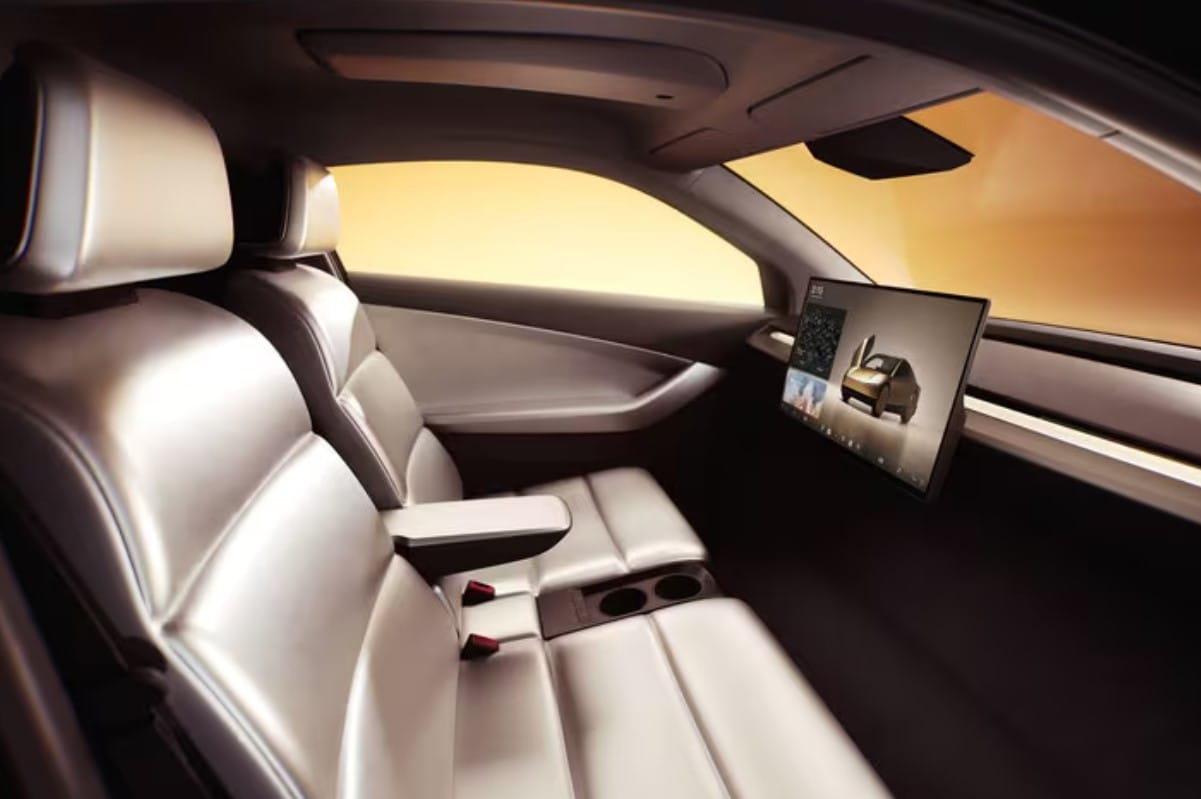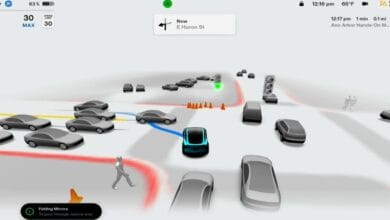(Cybercab) Tesla Robotaxi Like a Cybertruck

Tesla Inc will unveil the highly anticipated Robotaxi on October 10, 2024. Sources told Automotive News that the unveiling will take place at the Warner Bros. On the Los Angeles Area a studio Discovery movie. The studio, located in Burbank, is a historic film and television production set where iconic TV shows like Friends and films like Batman were shot. Let’s discuss details about Tesla Robotaxi 2025.
But Elon Musk apparently doesn’t want to lean on humdrum Model 3 sedans and Model Y SUVs for his Uber and AirBnb Driver competitor. The Tesla says it’s working on a purpose-built, dedicated robotaxi vehicle that Elon Musk indicated may be called the “Cybercab” on a recent earnings call.
Cybercab
Elon Musk put the name of Robotaxi is Cybercab. Cybercab is the hightly and most durability anticipated taxi. It’s a wildly ambitious plan, one that feels like the ultimate extension of Tesla’s longtime bet on its Autopilot and so-called Full Self-Driving systems. It’s also extremely unproven, hinges on aggressive buildouts of brand-new technologies, depends on an uncertain level of consumer support, depends on regulations that don’t even exist yet and will require Autopilot and FSD can survive a maze of legal challenges and even a federal criminal investigation.
In other words, it’s easily Musk’s biggest and riskiest swing to date—and far from certain in any way, shape or form. Nevertheless, let’s take a look at what we think we know so far, based on the company’s various statements and concept artwork seen here and there.

For at least a decade, Musk has beaten the drum that self-driving capability was coming to Teslas any day now. Autonomous Teslas, he’s said over the years, could earn their owners significant side income by ferrying passengers around when they’d otherwise be parked. None of that has happened yet.
In recent years, Tesla executives also started mentioning the idea of a purpose-built Tesla robotaxi. That is, not just a regular Tesla that can also drive autonomously sometimes but rather a vehicle designed from the ground up to do just that.
The Tesla robotaxi plan has taken precedence over more conventional—and arguably, more prudent—projects at Tesla. In April, Reuters reported that Tesla had scrapped plans for a cheap mass-market vehicle, known colloquially as the Model 2, in favor of going all-in on the robotaxi. (Musk has indicated that this more affordable model is still in the cards, but it doesn’t seem to be a priority.)
When Is The Tesla Robotaxi Reveal?
In April, Musk said in a post on X that Tesla will unveil the robotaxi on August 8. Then, in July, Bloomberg reported that Tesla planned to postpone the event until October. According to the outlet, Tesla teams needed more time to build additional robotaxi prototypes.
During Tesla’s Q2 2024 earnings call, CEO Elon Musk announced that October 10th will be the date of the reveal of the Robotaxi.
When Is The Tesla Robotaxi Release Date?
So far, Tesla hasn’t managed to crack autonomous driving in its current cars. It sells a feature marketed as “Full Self-Driving,” but that system requires driver supervision and is far from perfect.
Tesla would need to deliver reliable self-driving technology before it could deploy robotaxis without steering wheels, and it’s not clear when or if that will happen.
On Tesla’s Q2 2024 earnings call, Musk said in response to an investor question that Tesla could not start offering rides to customers until Full Self-Driving can be used unsupervised. In its earnings report issued Tuesday, Tesla said that the “timing of Robotaxi deployment depends on technological advancement and regulatory approval.”
The fact that the robotaxi will be revealed tonight doesn’t necessarily mean it’s anywhere close to production. Tesla unveiled the Cybertruck pickup late 2019, and the first trucks didn’t reach customers until a full five years later. A design for a forthcoming supercar, the Tesla Roadster, broke cover in 2017 and still hasn’t seen the light of day.

What Will The Tesla Robotaxi Look Like?
Now that it’s been revealed, we know exactly what it looks like. However, even prior to it debut, we had a good idea of what to expect. In 2022, Musk said that the robotaxi will lack a steering wheel and pedals and called its design “futuristic.” Walter Isaacson, Musk’s biographer, reported that an early design for the vehicle had a “Cybertruck futuristic feel.” That could indicate a more angular, polygonal aesthetic than the streamlined Model 3 and Model Y.
He shared an illustration in his book, Elon Musk, which depicts a small, two-seat vehicle with a teardrop shape. In April, Musk referred to the robotaxi as the Cybercab. It’s not clear that that’s the model’s actual name, but it would make sense given the reportedly Cybertruck-like styling.
In a video posted to X, Tesla dropped some additional teasers. The clip shows what may end up being the robotaxi’s front bumper and white interior.
In the past, Tesla has said it would build the robotaxi using its lower-cost, next-generation vehicle platform. Recently, however, Tesla said it’s accelerating new-vehicle projects by using a hybrid of its current and next-generation technologies. It’s unclear what technology will underpin the robotaxi.
How Will Tesla’s Uber Competitor Work?
On an earnings call, Musk described Tesla’s taxi service as a combination of Airbnb and Uber. The idea is that Tesla’s fleet will include both its own robotaxis and the vehicles of Tesla owners who opt in—i.e., you own the car and when you aren’t operating it, you can “rent” it out for Tesla robotaxi duty.
That’s something that Musk has promised for years, in various forms. Back in 2019, he said that up to a million Model 3s on U.S. roads would be deployable as fully autonomous (SAE Level 5) robotaxis by 2020. In case you haven’t noticed, that did not happen.
Still, Tesla is clearly thinking in that direction. In its earnings report, the automaker shared some renderings of what a Tesla ride-hailing app may look like.

How is Tesla’s Robotaxi different from Waymo, Cruise and Zoox?
Waymo and Cruise, autonomous taxi outfits owned by Alphabet and General Motors, respectively, both use modified versions of off-the-shelf electric vehicles for their operations. Waymo uses Jaguar I-Paces, while Cruise uses Chevrolet Bolts.
As they’ve developed their their self-driving technology on public roads, both companies have used safety drivers who can monitor and take over if something goes wrong. Cruise, which paused operations after hitting a pedestrian late last year, is slowly redeploying its vehicles with people in their drivers’ seats.
Zoox, Amazon’s self-driving startup, is working on a taxi service that uses purpose-built, pod-like vehicles without steering wheels. But it’s still in the testing phase and hasn’t launched commercial operations yet.
Unlike any of those firms, Tesla insists that it can achieve reliable self-driving capability using only cameras. Other autonomous-driving efforts rely on more sensors, including LiDAR units that use lasers to create a three-dimensional image of the world. Many autonomous vehicle experts doubt that Tesla’s pared-back, vision-only approach will bear fruit.
What Roadblocks Hold This Up?
How much time do you have? First and foremost, the plan depends on Tesla “solving” the question of fully autonomous driving, something many other experts have warned is decades away, not years, if it ever happens at all. And Tesla has traditionally eschewed technologies for autonomy that other automakers support, like LIDAR. Instead, it’s trying to train AI using cameras, sensors and supercomputers.
Moreover, the U.S. isn’t set up for a vast Tesla robotaxi network of any kind. While robotaxi testing and pilot programs are happening in about 10 states, no true, sweeping federal regulations for them exist. There are questions of accident liability and other matters that have to be solved first. And as we alluded to earlier, Tesla’s existing FSD and Autopilot technologies have been dogged by high-profile crashes, lawsuits, state investigations and even a Department of Justice probe examining whether the automaker deceived investors and consumers over what its driver-assistance systems can do.
So Why Does The Tesla Robotaxi Matter?
Tesla Inc, its enthusiastic investors and bullish Wall Street analysts believe that autonomous driving will help the automaker rake in huge amounts of money over time. That’s partially why Tesla is valued so richly.
As of this writing, it’s worth $544 billion, about ten times the market caps of competitors like Ford and General Motors. A functional Tesla robotaxi will be key if Tesla wants to live up to the expectations its sky-high stock price has set.

